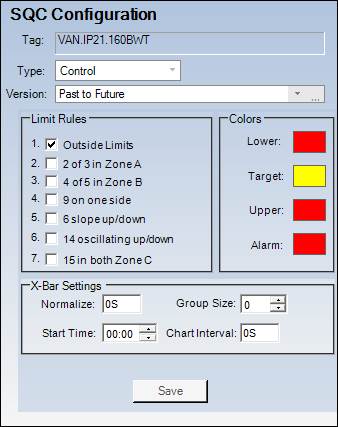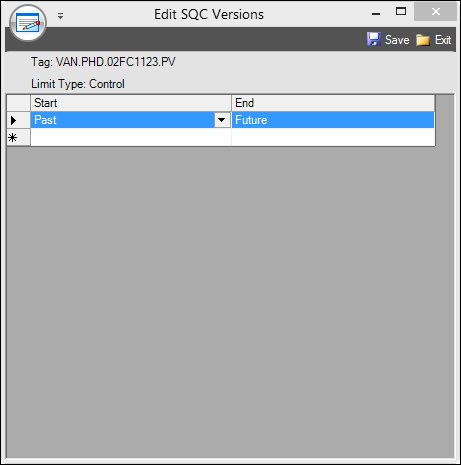- 05 Feb 2024
- Print
- PDF
SQC Configuration
- Updated on 05 Feb 2024
- Print
- PDF
SQC Configuration defines the rules that will be applied for evaluating the alarm state of each tag. The default is to simply use the outer limits of the tag. The alarm limit colors can also be set. This controls the color of the limits when they are displayed on a trend.

Tag: The tag that the SQC rule will affect. It is the same as the tag whose limits are being configured. It is not editable. It is only used for reference.
Type: The limit type. Limit types can be configured in System Configuration. Typical default limits are Control and Spec where Control are inner limits and Spec are outer limits. In other words, control limits could reflect optimal process conditions while spec limits could reflect boundaries that cannot be exceeded or else the product is not salable.
Version: The version of the SQC configuration that is being configured. Use the ellipsis (…) button to open the Edit SQC Versions window. Otherwise, use the dropdown list to select a version. If the default “Past to Future” is used, it will apply at all times.
Edit SQC Versions: Used to create a version. Once a version is created, it can be selected from the drop down list. The Start and End times define each version. Click the “Save” option in the menu bar to save the version changes.

If version Start and End times are changed for versions in the past, the Alarm server will not automatically re-evaluate historical alarms based on the change. A backfill must be performed.
Limit Rules
Rules can be individually selected for application to a tag. Note that applying too many rules to a single tag can create an overabundance of violations that might not necessarily be useful.
Outside Limits: Will alarm when at least one process point falls outside of the upper or lower limit of the process. This ruled is selected most often.
2 of 3 in Zone A: Will alarm when at least 2 of 3 consecutive points fall in zone A.
4 of 5 in Zone B: Will alarm when 4 of 5 of points are in zone B or farther from the target.
9 on one side: Will alarm if 9 consecutive points fall either above or below the target line.
6 slope up/down: Will alarm when six consecutive points have an increasing or decreasing slope. In other words if there is no oscillation for six points and the trend is increasing or decreasing for the entire six points.
14 oscillating up/down: Causes an alarm if there are 14 consecutive points that change direction every point.
15 in Zone C: Will alarm when fifteen consecutive points fall within one standard deviation.
Colors
Lower: The color of the lower limit line on a trend.
Target: The color of the target line on a trend.
Upper: The color of the upper limit line on a trend.
Alarm: The color that a trend line will become when it enters the alarm state.
X-Bar Settings
Normalize: Step size used when retrieving the data for alarm evaluation. Only used for real-time data, not lab data. 5S is 5 seconds, 1M is 1 minute.
Group Size: Number of data points grouped for calculating the R and X-Bar R charts.
Start Time: For repeatable results a start time for evaluating alarms is required. It is usually midnight, 00:00. Step intervals will be calculated from this time.
Chart Interval: Interval between points on a chart. 5S is 5 seconds, 1M is 1 minute.
Save: Saves the SQC configuration changes. They must be saved using this button. Clicking the Save icon at the top of the window will not save these changes.

